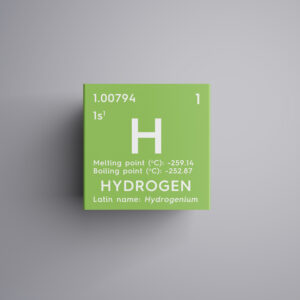Many experts today point to hydrogen as the ultimate clean energy source. However, the cleanliness of this fuel boils down to how the hydrogen is sourced, produced, and extracted. While the gas itself is invisible, a widely used system of hydrogen colors as codes helps to identify and describe how hydrogen was produced and the CO2 footprint of production.
With this color scheme, you can instantly tell if the hydrogen production method resulted in greenhouse gas emissions and, if so, to what extent.
Regardless of how it is created, hydrogen will only exhaust water as a byproduct when burned. But creating hydrogen, as it turns out, can be highly carbon intensive.
Fortunately, various steps can be taken to lower this impact. Some of these methods have just recently been developed in the last decade, and other methods are centuries old. Scientists assign colors to hydrogen to identify how it was produced.
Production methods determine if hydrogen is classified as green, blue, turquoise, or grey. Some other interesting hydrogen production colors include pink and yellow. Black and brown hydrogen are considered the worst in terms of the carbon intensity of production.
While the naming conventions vary across regions and countries, these color codes remain standard.
The best hydrogen colors are green and turquoise. This is because green hydrogen is produced in a climate-neutral way, and turquoise hydrogen can be produced in a carbon-negative way when the feedstock in biogas. As a result, both methods have essential roles to play in our global effort to reduce emissions to net zero in the coming decades.
Hydrogen Gas Is Abundant
The best thing about hydrogen is that it is the simplest yet most abundant element in the world and the universe. On Earth, hydrogen is rarely found on its own or as a gas. As a result, hydrogen usually has to be produced by separating it from other elements, the most common of which are oxygen (with hydrogen present in water) and carbon (with hydrogen present in hydrocarbons).
The color white is assigned to naturally occurring hydrogen, only found underground in its pure form on Earth. There are a few ways of pulling this terrestrial hydrogen out of the ground, but extracting it is expensive. This is why experts are looking for functional and economical options to manufacture it, and they use the hydrogen color system to describe the differences.
Green Hydrogen
Green hydrogen is generally viewed as the gold standard because it is produced using environmentally friendly and renewable methods. The most common process used to produce green hydrogen is called electrolysis.
Essentially electrolysis works by splitting water into hydrogen and oxygen atoms. To be classified as Green, the energy needed to electrolyze/split this water must be generated from a renewable electricity source like solar, wind, or hydropower.
Since both the oxygen and hydrogen produced by electrolysis are not harmful to the environment, the net result is zero emissions, making this category of hydrogen production carbon neutral.

Turquoise Hydrogen
Turquoise (a hydrogen color between blue and green) refers to the creation and production of hydrogen using a thermal process that breaks natural gas into hydrogen and solid carbon. In this process, individual carbon atoms bind with other carbon atoms (instead of oxygen, nitrogen, or hydrogen) and do not combust.
When the heating source is clean (ex: combustion of hydrogen or powered by renewable electricity) and the feedstock is natural gas, this entire process is classified as carbon neutral because no CO2 is produced.
The reactors and furnaces used to split methane for turquoise hydrogen are often powered by some form of renewable energy and even hydrogen. When the production of turquoise hydrogen utilizes biogas from a landfill or a wastewater treatment facility, the entire process is CO2 negative because the net result is the sequestration of more CO2 than you produced. The solid carbon output from turquoise hydrogen can be used by industry for construction materials, tires, and asphalt.
Blue Hydrogen
While Green hydrogen is considered the best long-term option of the hydrogen colors, blue hydrogen is the most widely understood production approach for carbon neutral hydrogen. Unfortunately, these methods are largely hypothetical and the most expensive options on the market today. Blue hydrogen is mainly generated by reforming natural gas via steam. The process involves splitting natural gas into CO2 and hydrogen.
This steam methane reforming process does not end up with carbon dioxide being emitted into the atmosphere. Instead, the CO2 is supposed to be captured and either diverted into industrial processes or pressurized, and pumped to a CO2 sequestration site. Unfortunately, the assumed CO2 capture and sequestration associated with blue hydrogen is very difficult to scale economically and has yet to be proven.
Blue hydrogen production is often coupled with Carbon Capture and Storage (CSS) technologies which work by capturing CO2 and storing it underground. The result is that blue hydrogen is supposed to be net-neutral carbon because it does not release emissions. Still, there is a long-term impact associated with this method as a result of the need to capture and store carbon dioxide. The risks include CO2 system leakage and other environmental issues that are still not entirely understood.
Gray Hydrogen
Gray hydrogen is the type we need to stop using sooner rather than later. It is the opposite of green hydrogen because it is highly polluting when produced. Gray hydrogen is extracted by burning coal or natural gas to produce steam.
This steam is then used to reform other fossil fuels like coal or natural gas into hydrogen. The process emits huge amounts of CO2 into the atmosphere due to the heating and hydrocarbon splitting processes.
It is worth noting that for every ton of gray hydrogen produced, this method results in ten tons of carbon dioxide released into our atmosphere. Clearly, gray hydrogen is not environmentally friendly. Furthermore, gray hydrogen can also result from a process that uses electricity derived from fossil fuels and other non-renewable sources to power water electrolysis or other similar processes to extract hydrogen.
Many countries have already started cracking down on industries that produce hydrogen using these carbon-intense methods, especially as availability for other hydrogen colors increases.
Other Hydrogen Colors
The hydrogen colors referenced above are used to classify the most common methods for producing hydrogen gas. Other less common production methods like pink hydrogen, red, and violet hydrogen are used to identify hydrogen gas produced using different techniques powered by nuclear energy.
Yellow hydrogen is produced using a mixture of fossil fuels and renewables. Interestingly, hydrogen produced as a byproduct of other primary chemical reactions or processes is referred to as white hydrogen, just like the naturally occurring hydrogen found underground.
Brown hydrogen is often a result of a process that involves coal. The process almost always yields significant amounts of CO2 and other atmospheric pollutants.

What’s the best choice of the hydrogen colors?
Hydrogen production is one of the fastest growing sectors of the world economy. As a result, many experts believe that hydrogen will soon be instrumental in meeting our local and national net zero emissions goals.
However, whether it is fueling fuel cell electric vehicles and class-8 trucks or producing heat or power, the keys to high-value hydrogen are low carbon intensity, low economic cost, and near-term availability. Green hydrogen is by far the most expensive hydrogen production option today, but it is the cleanest option and should eventually become cheaper than most other hydrogen production methods.
Finally, the full lifecycle carbon intensity and cost benefits of different hydrogen approaches must go beyond production alone. The post-production steps of transporting hydrogen via truck or newly constructed pipelines and storing it in newly fabricated tanks (on freshly poured cement pads) all have their carbon intensity scores that must be factored in.
Hydrogen from natural gas, “is viewed by [The Department of Energy] as a bridge technology to enable future energy scenarios where hydrogen is sustainably produced using all the diverse domestic resources,” according to the DOE Office of Energy Efficiency and Renewable Energy.
This is one of the reasons that, of all the hydrogen colors, distributed on-site pyrolysis of methane is one of today’s most promising approaches to generating clean, turquoise hydrogen and decarbonizing natural gas.


